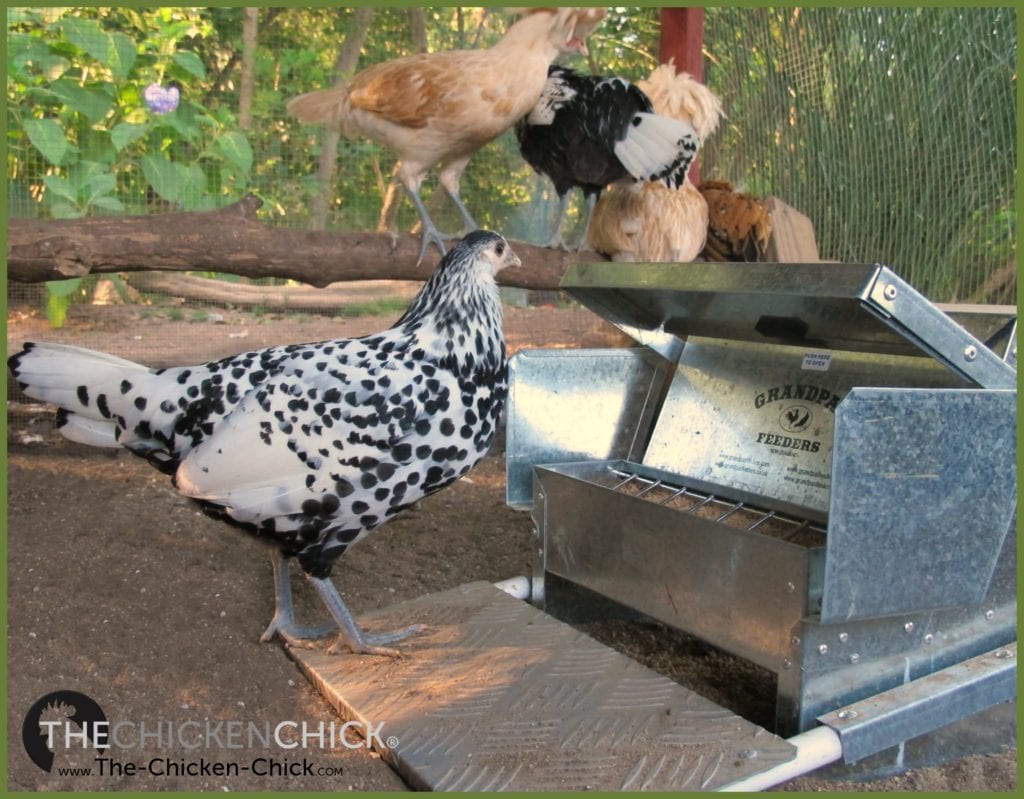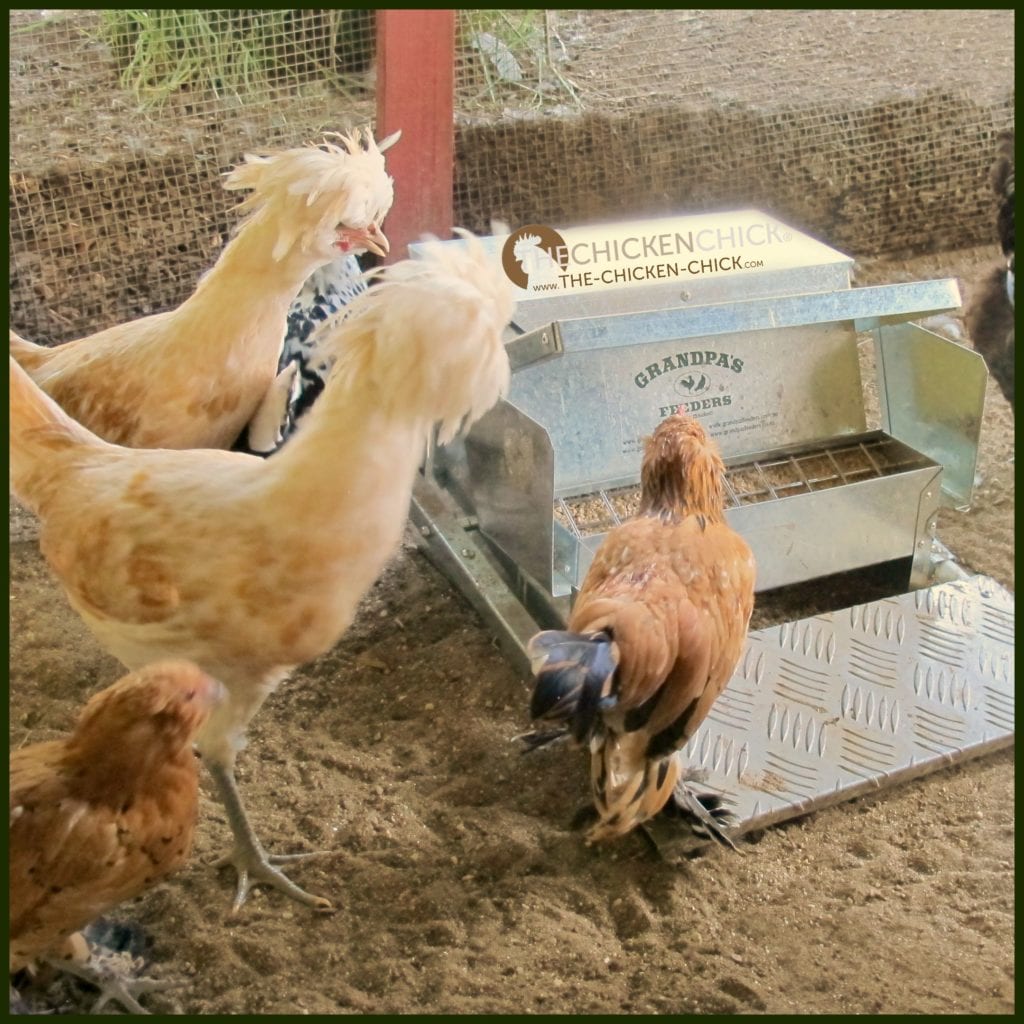The U.S. Department of Agriculture estimates that approximately $2 billion in poultry feed is destroyed by rodents annually. Extrapolating from the startling data found here, I calculated that 25 rats can consume 500 pounds of feed per year. But financial loss to rodent consumption is not the only price paid for their presence in the chicken yard they are known carriers of approximately 45 diseases, including salmonellosis, pasteurellosis, leptospirosis, swine dysentery, trichinosis, toxoplasmosis and rabies. Mice and rats can carry disease-causing organisms on their feet, contaminating ten times the amount of feed they consume with droppings, urine and hair. So, between the risk of disease posed to my flock and the consumption of costly chicken feed, I began to realize that a well constructed treadle feeder that denies rodents access is worth its weight in gold.
This treadle feeder has a cantilevered lid over the feed trough that lifts to expose the feed when a chicken steps onto the attached platform and closes automatically when the chicken steps off it.
FEATURES
- The standard feeder requires 14 ounces of weight to open the lid. An adult rat weighs approximately 9 to 11 ounces. Rats, mice, sparrows, rabbits, squirrels, etc. are all too light to open it.
- Anti-flick grill: prevents the birds from scooping feed out of the trough onto the dirty ground where coccidiosis and other diseases can contaminate the feed.
- Capacity: a standard feeder holds 20 lbs of feed, which services approximately 6 chickens for 10 days. Vacation, anyone?
- This treadle feeder is made of galvanized steel with an alloy tread plate. They are waterproof and can be used inside or out.
- Poop-proof-chickens can’t poop in it when the lid is closed.
TRAINING
There is a training period that allows the birds to become accustomed to the operation of the feeder, but it requires no effort on the part of the chicken-keeper. Chickens are distrustful of change because as prey animals, new things can mean a predator is behind it.
For the first week of training, two bolts prop the lid open fully and the birds get a feel for standing on the plate and putting their heads into the trough to eat.
The second week, the bolts are lowered a notch so that the plate and lid move slightly when the plate is stepped on.
The third week, the bolts are removed and the birds operate it themselves- when they step on the plate, the lid opens, when they step off, the lid closes.
My Polish pullets, Calista Flockheart and Ally McBeak, were the first to explore the standard feeder as the bigger birds looked on curiously. Within the first week, everyone in my flock was eating from the feeder!
This feeder is available in 2 sizes HERE.
Kathy Shea Mormino
Affectionately known internationally as The Chicken Chick®, Kathy Shea Mormino shares a fun-loving, informative style to raising backyard chickens. …Read on


shop my SPONSORS
The U.S. Department of Agriculture estimates that approximately $2 billion in poultry feed is destroyed by rodents annually. Extrapolating from the startling data found here, I calculated that 25 rats can consume 500 pounds of feed per year. But financial loss to rodent consumption is not the only price paid for their presence in the chicken yard they are known carriers of approximately 45 diseases, including salmonellosis, pasteurellosis, leptospirosis, swine dysentery, trichinosis, toxoplasmosis and rabies. Mice and rats can carry disease-causing organisms on their feet, contaminating ten times the amount of feed they consume with droppings, urine and hair. So, between the risk of disease posed to my flock and the consumption of costly chicken feed, I began to realize that a well constructed treadle feeder that denies rodents access is worth its weight in gold.
This treadle feeder has a cantilevered lid over the feed trough that lifts to expose the feed when a chicken steps onto the attached platform and closes automatically when the chicken steps off it.
FEATURES
- The standard feeder requires 14 ounces of weight to open the lid. An adult rat weighs approximately 9 to 11 ounces. Rats, mice, sparrows, rabbits, squirrels, etc. are all too light to open it.
- Anti-flick grill: prevents the birds from scooping feed out of the trough onto the dirty ground where coccidiosis and other diseases can contaminate the feed.
- Capacity: a standard feeder holds 20 lbs of feed, which services approximately 6 chickens for 10 days. Vacation, anyone?
- This treadle feeder is made of galvanized steel with an alloy tread plate. They are waterproof and can be used inside or out.
- Poop-proof-chickens can’t poop in it when the lid is closed.
TRAINING
There is a training period that allows the birds to become accustomed to the operation of the feeder, but it requires no effort on the part of the chicken-keeper. Chickens are distrustful of change because as prey animals, new things can mean a predator is behind it.
For the first week of training, two bolts prop the lid open fully and the birds get a feel for standing on the plate and putting their heads into the trough to eat.
The second week, the bolts are lowered a notch so that the plate and lid move slightly when the plate is stepped on.
The third week, the bolts are removed and the birds operate it themselves- when they step on the plate, the lid opens, when they step off, the lid closes.
My Polish pullets, Calista Flockheart and Ally McBeak, were the first to explore the standard feeder as the bigger birds looked on curiously. Within the first week, everyone in my flock was eating from the feeder!
This feeder is available in 2 sizes HERE.
































I am still catching jokes from hubby about my solar powered, light sensored automatic door lol, but I love it and I'm glad I splurged for it. I can see the value in this to, as mentioned when the rain blows my swing feeder clumps up and food is wasted. I still may have to put it on my wish list.
The price issue is a real one, but consider how much money you are losing in feed to waste due to rodents, rain and wind. It'll pay for itself in no time.
My Silkie can open it with no problem. If you have a random chick, you can always put in a small chick feeder for her and remove it at night.
I have a swing 11 pound feeder with a cone cover. I can never fill it though due to the rain (causes the food to clump in the feeder and rot). I like the idea of this keeping blowing rain our of my feed (and wasting it), unwanted rodents and feed spilling on the ground and poo.
I do wonder about the chick warning though. How do you deal with that if you have the odd chick (mother nature and a rooster in the hen house and all)? Do silkies have issues with this? Oh and the price.
It doesn't look like this feeder would be possible for scratching the feed out either. I like that.
This looks easier than using my T-shirt. :)